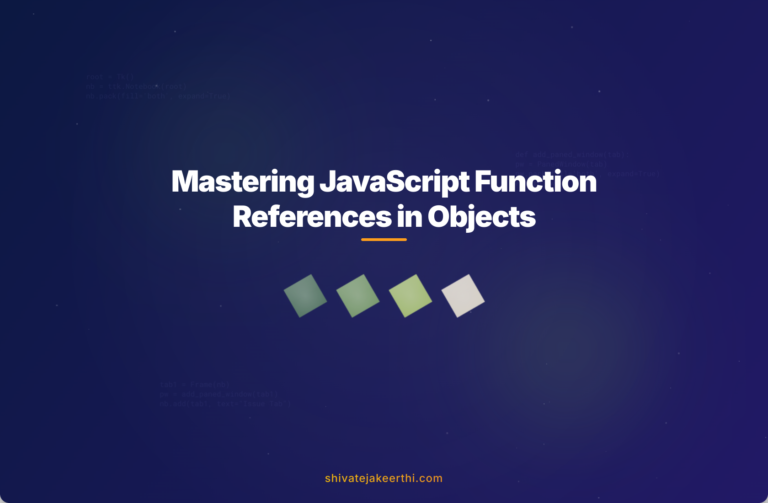Creating interactive projects can bring challenging scenarios with JavaScript, especially when managing functions and objects referencing each other. The practice game project we’ll discuss today faced a specific issue: making functions and objects communicate clearly without initialization errors or unexpected behaviors.
Understanding Functions and Objects in JavaScript
JavaScript heavily relies on functions, which are blocks of reusable code designed to perform specific tasks. Think of JavaScript functions like tools you keep in a toolbox. You pick the right tool for your job, use it, then put it back until it’s needed again.
// Example of a simple JavaScript function
function greet(name) {
console.log("Hello, " + name + "!");
}
greet("Alice"); // Outputs: Hello, Alice!
Objects, on the other hand, bundle up your data and related functions neatly into a single package. Objects are like organized filing cabinets: each file (property or method) has a label and a value that makes it easy to find and use when necessary.
You typically create JavaScript objects using curly braces:
// Simple object example
const plant = {
name: "Sunflower",
color: "Yellow",
grow: function() {
console.log(this.name + " is growing.");
}
};
plant.grow(); // Outputs: Sunflower is growing.
Challenges When Objects Reference Functions
In our plant-based JavaScript game, we faced a tough issue: our objects needed to directly reference certain functions. However, calling a function within an object can lead to confusion, especially if the function is not yet fully initialized during the object’s creation.
Why does this happen? JavaScript initializes code from top to bottom. When you reference a function within an object before JavaScript fully initializes it, the value becomes undefined. It’s like sending a letter to an address that’s still under construction—you can’t deliver it if the address isn’t ready yet.
What Solutions Did We Try?
One initial attempt was placing the entire plants array inside the newPlant() function directly:
// Incorrect approach example
function newPlant() {
const plants = [
{ name: "Rose", action: bloom() },
{ name: "Sunflower", action: grow() }
];
function bloom() { console.log("Blooming!"); }
function grow() { console.log("Growing!"); }
}
This approach caused a significant issue: “Cannot access function before initialization” errors. That’s because the objects were referencing functions defined afterward, making them inaccessible at the required time.
Another attempted fix involved using the JavaScript this keyword, a common practice intended to reference methods within an object itself:
const plant = {
name: "Rose",
bloom: function() {
console.log(this.name + " is blooming.");
},
initiate: function() {
this.bloom();
}
};
plant.initiate();
While this method works in cases where the function is directly within the same object, it becomes complicated if functions are defined externally or referenced too early.
Code Review: What Went Wrong?
Looking closely, the main issue stemmed from improper structure and referencing. Defining functions **after** attempting to use them causes JavaScript’s interpreter to throw undefined errors. Moreover, inconsistency in the structure makes the code harder to maintain and debug.
In short, objects should reference clearly defined or pre-initialized functions, preferably maintaining a careful sequence of initialization.
Better Approaches for Function-Object References
To overcome these issues, you can consider these straightforward yet robust solutions:
- Define functions first: Before creating an object that references a function, define the function explicitly above the object.
- Separate responsibilities: Keep function definitions external and call them only after explicitly defining them, rather than embedding them directly into object properties prematurely.
For instance:
// Corrected example
function bloom() {
console.log("Blooming beautifully!");
}
function grow() {
console.log("Growing rapidly!");
}
const plant = {
name: "Lily",
actionBloom: bloom,
actionGrow: grow
};
plant.actionBloom(); // Blooming beautifully!
By assigning functions as property values (without parentheses), you avoid calling them prematurely. Instead, these functions execute only when explicitly invoked via the object’s method.
Understanding Event Listeners and JavaScript Buttons
Another related challenge arises with event listeners. Event listeners let your JavaScript program know when to trigger an action—such as a mouse click or button press. Proper event handling is essential in games, forms, and interactive apps.
In our project, buttons used event listeners to select plants, initiate planting, or perform random selections:
// Adding an Event Listener to a button
document.getElementById("plantBtn").addEventListener("click", function() {
newPlant();
});
Through proper event listener setups, your buttons can effectively communicate with your functions and objects, ensuring smooth gameplay or user interactions.
Optimizing Your JavaScript Code
Optimizing your code structure boosts efficiency, readability, and maintainability. To improve function initialization and referencing:
- Structure clearly: Place function definitions at the top or in a dedicated section before usage.
- Use self-contained, reusable functions: Don’t nest functions excessively; keep them simple, reusable, and well-named.
- Assign functions to objects after initialization: Reference existing functions rather than creating undefined calls.
Randomizing Plant Selection
Our project also required random selection of plants. Simple JavaScript randomization helped achieve unpredictable gameplay. Here’s a common random plant selection snippet:
const plants = ["Rose", "Sunflower", "Tulip"];
function randomPlant() {
const randomIndex = Math.floor(Math.random() * plants.length);
return plants[randomIndex];
}
console.log(randomPlant()); // Outputs a random plant from the array
The algorithm provided randomness essential for keeping the game engaging and unpredictable for players.
Randomization functions significantly enhance your code’s interactivity, creating dynamic applications that engage users better.
Final Recommendations for Better Practice
Organizing your JavaScript properly from the outset saves time spent debugging later. To avoid common pitfalls:
- Always define your functions clearly at the top.
- Reference functions in objects **without calling them prematurely** (avoid parentheses immediately following function names).
- Leverage efficient coding practices like proper event listener setup and clearly structured code blocks.
Additional Resources
To explore deeper or experiment with your own projects, consider checking out the following resources:
- Explore our detailed JavaScript tutorials.
- Find specific solutions on Stack Overflow.
- Dive deeper into MDN JavaScript Guide.
Additionally, our practice game project code is available publicly on GitHub—feel free to review, clone, or fork it.
What’s your experience connecting functions and objects in JavaScript? Do you have simpler solutions in your projects? Let us know!



0 Comments